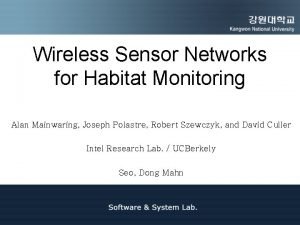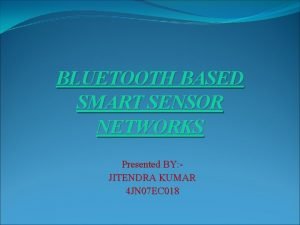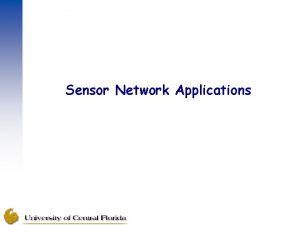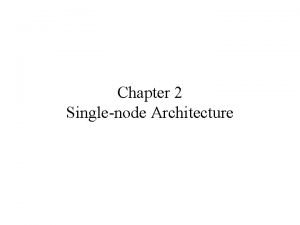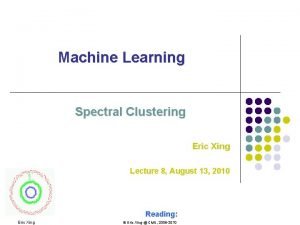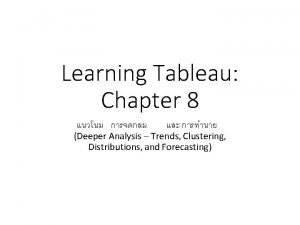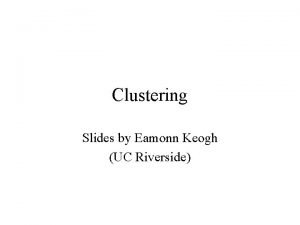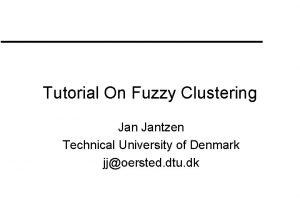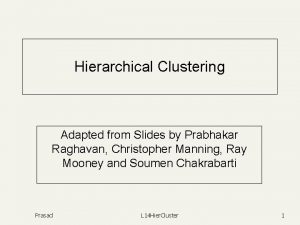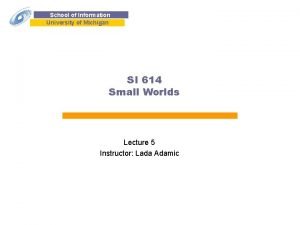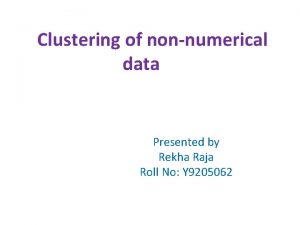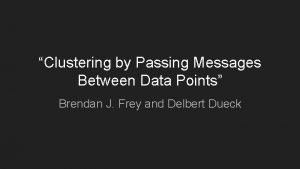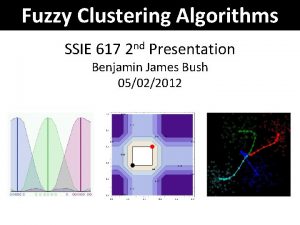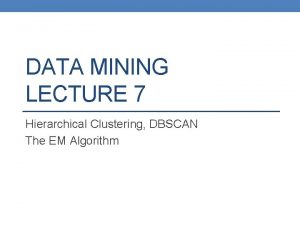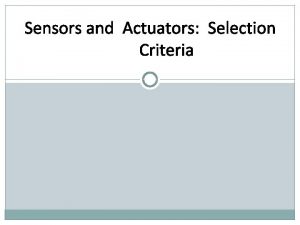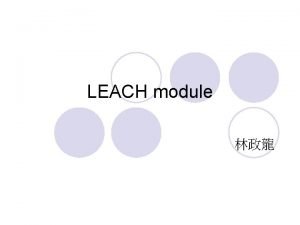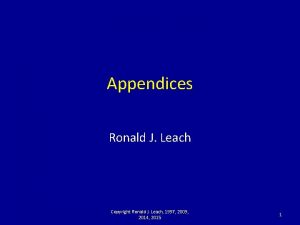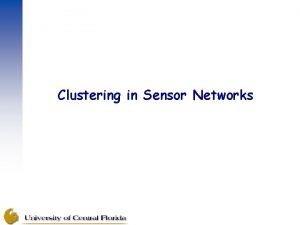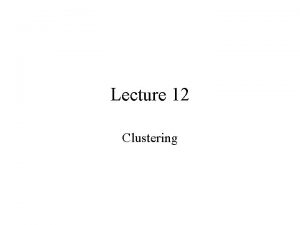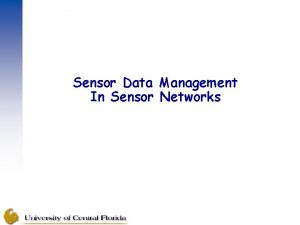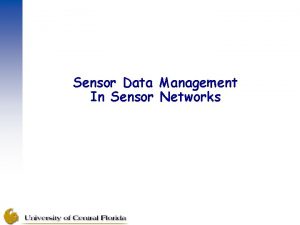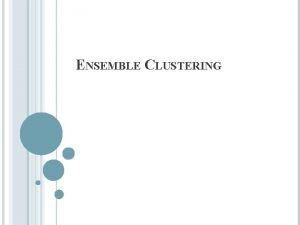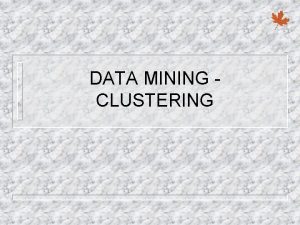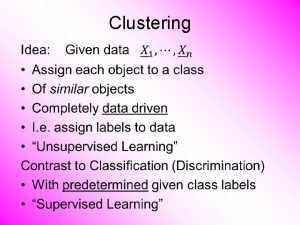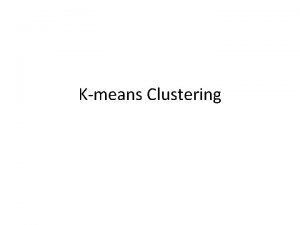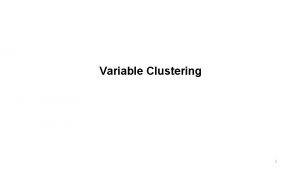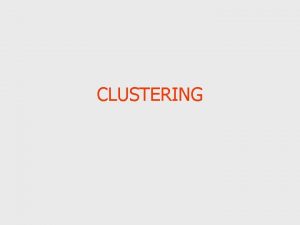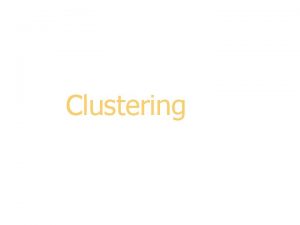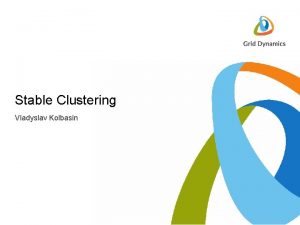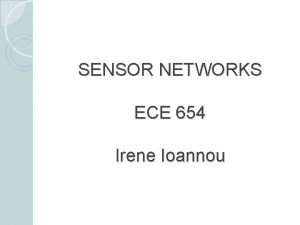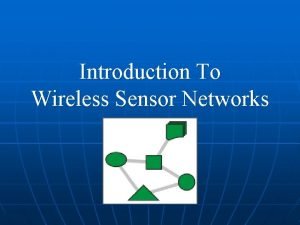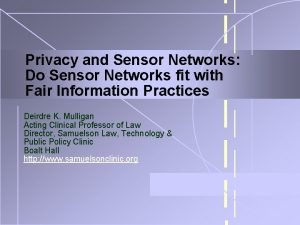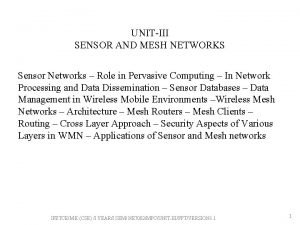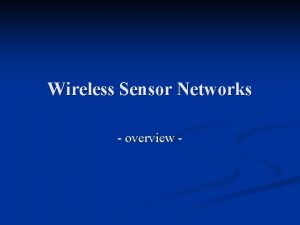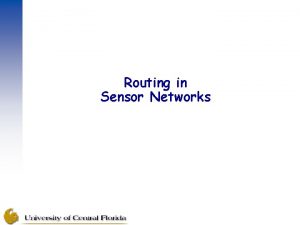Sensor Networks Lecture 8 LEACH Clustering LEACH Low













![Geographic Routing [Ref. 11] • For dense sensor networks such that a sensor is Geographic Routing [Ref. 11] • For dense sensor networks such that a sensor is](https://slidetodoc.com/presentation_image_h2/0be566f58eb32d111130457d844dc915/image-14.jpg)







![Fault Tolerant Data Propagation • Reference: [12] listed at the end • Use path Fault Tolerant Data Propagation • Reference: [12] listed at the end • Use path](https://slidetodoc.com/presentation_image_h2/0be566f58eb32d111130457d844dc915/image-22.jpg)




![Energy-Efficient Clustering • Reference: [13] listed at the end • Two key parameters: – Energy-Efficient Clustering • Reference: [13] listed at the end • Two key parameters: –](https://slidetodoc.com/presentation_image_h2/0be566f58eb32d111130457d844dc915/image-27.jpg)

![On Optimal Path and Source Redundancy in Sensor Networks • Reference: [14] listed at On Optimal Path and Source Redundancy in Sensor Networks • Reference: [14] listed at](https://slidetodoc.com/presentation_image_h2/0be566f58eb32d111130457d844dc915/image-29.jpg)




- Slides: 33

Sensor Networks Lecture 8

LEACH Clustering • LEACH: (Low Energy Adaptive Clustering Hierarchy) rotates cluster heads to balance energy consumption • Each cluster head performs its duty for a period of time • Each sensor makes an independent decision on whether to become a cluster head and if yes broadcasts advertisement packets

(. LEACH Clustering (cont • Each sensor that is not a cluster head listens to advertisements and selects the closest cluster head • Once a cluster head knows the membership, a schedule is created for the transmission from sensors in the cluster to the cluster head to avoid collision (e. g. , based on TDMA) • The cluster head can send a single packet to the base station (directly) over long distance to save energy consumption • No assurance of optimal cluster distributions

HEED Clustering • HEED (Hybrid Energy-Efficient Distributed clustering) uses the residual energy info for cluster head election to prolong sensor network lifetime • Probability of a sensor becoming a cluster head is: • Clusters are elected in iterations: – A sensor announces its intention to become a cluster head, along with a cost measure indicating communication cost if it were elected a cluster head – A non-CH sensor picks a candidate with the lowest cost – A non-CH sensor not covered doubles its CHprob in iterations until CHprob is 1, in which case the sensor elects itself to the cluster head

PEGASIS: Power-Efficient Gathering in Sensor Information Systems • A chain of sensors is formed for data transmission (could be formulated by the base station) • Finding the optimal chain is NP-complete • Sensor readings are aggregated hop by hop until a single packet is delivered to the base station: effective when aggregation is possible • Advantages: No long-distance data transmission; no overhead of maintaining cluster heads • Disadvantages: – Significant overhead: Can use tree instead – Disproportionate energy depletion (for sensors near the base station): Can rotate parent nodes in the tree

Aggregation/Duplicate Suppression • Aggregation of information in a tree structure – In-network information processing such as max, min, avg • Duplication Suppression: – On forwarding messages, sensor nodes whose values match those of other sensor nodes can simply annotate the message – Or just remain silent, on overhearing identical (or “similar enough”) values

Querying a Sensor Network • Can have sensor nodes periodically transmit sensor readings • More likely: Ask the sensor network a question and receive an answer • Issues: – Getting the request out to the nodes – Getting responses back from sensor nodes who have answers • Routing: – Directed Diffusion Routing – Geographic Forwarding (such as Geocasting)

Query-Oriented Routing • For query-oriented routing: Queries are disseminated from the base station to the sensor nodes in a feature zone • Sensor readings are sent by sensors to the base station in a reverse flooding order • Sensor nodes that receive multiple copies of the same message suppress forwarding

Query: Asking a Question

Response to Base Station: Initial

Directed Diffusion Routing • Direction: From source (sensors) to sink (base station) • Positive/negative feedback is used to encourage/discourage sensor nodes forwarding messages toward the base station – Feedback can be based on delay in receiving data – Positive is sent to the first and negative is sent to others • A node will forward with low frequency unless it receives positive feedback • This feedback propagates throughout the sensor network to suppress multiple transmissions • Eventually message forwarding converges to the use of a single path with data aggregation for energy saving from the source to the base station

Responses, After Some Guidance • Use directed diffusion based on positive/negative feedback to guide response message forwarding

Directed Diffusion Routing Cont. • Pros – On demand route setup – Each node does aggregation and caching, thus good energy efficiency and low delay • Cons – Query-driven, not a good choice for continuous data delivery – Extra overhead for data matching and queries
![Geographic Routing Ref 11 For dense sensor networks such that a sensor is Geographic Routing [Ref. 11] • For dense sensor networks such that a sensor is](https://slidetodoc.com/presentation_image_h2/0be566f58eb32d111130457d844dc915/image-14.jpg)
Geographic Routing [Ref. 11] • For dense sensor networks such that a sensor is available in the direction of routing • Location of destination is sufficient to determine the routing orientation • Research issue: – selecting paths with a long lifetime for delivering messages between sensors, or from sensors to a base station without excessively consuming energy – Determining paths that avoid “holes” – determining the boundary or perimeter of a hole through local information exchanges periodically to trade energy consumption (for hole detection) vs. routing efficiency

Geographic Forwarding

References • Chapters 8 -11, F. Adelstein, S. K. S. Gupta, G. G. Richard III and L. Schwiebert, Fundamentals of Mobile and Pervasive Computing, Mc. Graw Hill, 2005. • Other References: • 10. X. Yu, “Distributed cache updating for the dynamic source routing protocol, ” IEEE Transactions on Mobile Computing, Vol. 5, No. 6, pp. 2006, pp. 609 -626. • 11. S. Wu and K. S. Candan, “Power-Aware Single and Multipath Geographic Routing in Sensor Networks, ” Ad Hoc Networks, Vol. 5, 2007, pp. 974– 997.

Fault Tolerance and Reliability • Sensor nodes are more susceptible to failure because of direct exposure to the environment and energy depletion • Failure and fault recovery are basic assumptions: incorporate redundancy to cope with failure • Performing consensus in a cluster for high reliability of measurement – Clustering based on sensing responsibility – Static vs. dynamic grouping • Dynamic grouping does not need to maintain state information and is more accurate (near the event) but incurs overhead in forming the group and reaching consensus

Searching for Agreement: Static Grouping

Searching for Agreement: Dynamic Grouping

MAC Layer Protocols • IEEE 802. 11 scheduling protocols are not suitable for wireless sensor networks because: – With RTS/CTS (Request to Send / Clear to Send) , collision can still occur because of hidden/expose terminal problems – Listening to traffic to avoid collision requires the nodes to stay on • TDMA is more suitable (requiring clock synchronization) – A number of reservation mini-slots can be used to reserve each of the transmission slots – Sensors can indicate whether or not they wish to transmit a message during the scheduling time segment – Nodes that are not planning to send or receive a packet need to stay on only during the reservation time slot to see if other sensors are sending a packet to them – Collisions are avoided, except for small reservation packets

Tradeoff between Energy Efficiency and Reliability/Performance • • An important design issue Improved reliability vs. energy consumption Aggregating sensor readings vs. loss of information Energy-efficient protocols often involve increased delay, loss of accuracy, reduced reliability and/or other performance penalty – Direct sensor-BS transmission vs. sensor-CH-BS – Sensor readings with redundancy • Achieving application requirements while prolonging lifetime is a major challenge
![Fault Tolerant Data Propagation Reference 12 listed at the end Use path Fault Tolerant Data Propagation • Reference: [12] listed at the end • Use path](https://slidetodoc.com/presentation_image_h2/0be566f58eb32d111130457d844dc915/image-22.jpg)
Fault Tolerant Data Propagation • Reference: [12] listed at the end • Use path redundancy to cope with sensor “reading” faults – One path (no redundancy) – Multiple paths to return sensor readings and a majority voting of the first three readings returned is performed to cope with faults – For example, use Time To Live (TTL) to indicate how many hops a sensor reading message is to be propagated, thereby creating multiple paths to propagate the sensor reading message from source to sink

Fault Tolerant Data Propagation • Source: node A • Sink: node I • When TTL = 3 hops, there are 7 paths from A to When TTL=4 hops, there are 21 paths

Fault Tolerant Data Propagation • • • An example Source: node E Sink: node I p: link fault probability (causing reading error) q: node fault probability (causing reading error) TTL=1: Reliability is 1 -p TTL=2: what is the reliability? – Three possible paths: E->I, E->H->I, E->F->I, with fault probability of p A A – System fails when two out of three paths fail, so reliability is 1 -p. A 2 -2 p. A(1 -A)-(1 -p)A 2 where A=1 - • (1 -q)(1 -p)2 =2 p+q-2 pq-p 2+p 2 q The more the path redundancy, the higher the reliability at the expense of more energy consumption

Energy Efficiency • Metric: Mean Time to Failure (MTTF) – Time till the first node dies (not useful) – Time half of the sensor nodes die (too arbitrary) – Time when the sensor network can no longer perform its intended function (yeah!) • Difficult to define precisely • Designing protocols so that – All the sensors die at roughly the same time – Sensors die in random locations instead of in specific locations

Balancing Energy Consumption • Clustering – is it always good? – Triangular routing: sensors -> cluster head -> base station – Overhead in selecting and rotating among sensors to be cluster heads – Good only if message aggregation is feasible; otherwise directly sending sensing readings to the base station may end up saving energy more
![EnergyEfficient Clustering Reference 13 listed at the end Two key parameters Energy-Efficient Clustering • Reference: [13] listed at the end • Two key parameters: –](https://slidetodoc.com/presentation_image_h2/0be566f58eb32d111130457d844dc915/image-27.jpg)
Energy-Efficient Clustering • Reference: [13] listed at the end • Two key parameters: – p: probability of a sensor becoming a cluster head – k: number of hops covered by a cluster • Find optimal (p, k) that would minimize the energy consumed

Energy-Efficient Clustering: Formulation • Sensors are distributed following a homogeneous spatial Poisson process with intensity → in a square area of size 4 a 2 • Per-hop distance is r • Energy model: each sensor uses 1 unit of energy to transmit or receive 1 unit of data • The information processing center is in the middle of the area • Idea: Define a function for the energy used and find (p, k) that would minimize the energy used
![On Optimal Path and Source Redundancy in Sensor Networks Reference 14 listed at On Optimal Path and Source Redundancy in Sensor Networks • Reference: [14] listed at](https://slidetodoc.com/presentation_image_h2/0be566f58eb32d111130457d844dc915/image-29.jpg)
On Optimal Path and Source Redundancy in Sensor Networks • Reference: [14] listed at the end • Analyze the effect of redundancy on MTTF and determine the optimal path and source redundancy level to maximize MTTF while satisfying reliability (Rreq) and timeliness (Treq) Qo. S requirements in WSNs. • Develop a hop-by-hop data delivery mechanism utilizing source and path redundancy with the goal to satisfy Qo. S requirements while maximizing the lifetime of the sensor system • Query: must return a sensor reading to the PC within the real-time deadline.

Cluster based WSN architecture

Hop-by-Hop Data Delivery Protocol

Hop-by-hop Data Delivery Protocol • Based on localized geographic routing • Path redundancy: Form m paths from a source CH to the PC: – m SNs in hop one relay the data through broadcasting – only one SN relays the data in each of the subsequent hops in each path • Source redundancy: Each of the ms SNs to communicate with the source CH through a distinct path: • only one SN relays the data through broadcast in each of the subsequent hops in each path

Probability Model • System MTTF - Total number of queries the system can answer before it fails due to energy depletion, sensor faults, or channel error • Rq - Reliability of a query as a result of applying the hop-by-hop data delivery mechanism with m paths for path level redundancy and ms sensors for source level redundancy
 Partitional clustering
Partitional clustering Rumus euclidean distance
Rumus euclidean distance Flat clustering
Flat clustering Wireless sensor networks for habitat monitoring
Wireless sensor networks for habitat monitoring Bluetooth based smart sensor networks
Bluetooth based smart sensor networks 09511 what network
09511 what network Habitat monitoring sensor
Habitat monitoring sensor Single node architecture in wireless sensor networks
Single node architecture in wireless sensor networks 01:640:244 lecture notes - lecture 15: plat, idah, farad
01:640:244 lecture notes - lecture 15: plat, idah, farad Victimas de ted bundy niña de 12 años
Victimas de ted bundy niña de 12 años Community leach pit
Community leach pit Isabella leach
Isabella leach Dialogue tonic
Dialogue tonic Darren leach
Darren leach Professor graham leach
Professor graham leach Richard leach maddox
Richard leach maddox Backbone networks in computer networks
Backbone networks in computer networks Difference between virtual circuit and datagram subnet
Difference between virtual circuit and datagram subnet Significant figures
Significant figures Low voltage = low hazard
Low voltage = low hazard Mid = (low + high) / 2
Mid = (low + high) / 2 Reflective communication style
Reflective communication style Cmu machine learning
Cmu machine learning Tableau clustering algorithm
Tableau clustering algorithm Clustering slides
Clustering slides Fuzzy clustering tutorial
Fuzzy clustering tutorial Hierarchical clustering
Hierarchical clustering A framework for clustering evolving data streams
A framework for clustering evolving data streams Clustering coefficient
Clustering coefficient Clustering non numeric data
Clustering non numeric data Windows server failover clustering (wsfc)
Windows server failover clustering (wsfc) Clustering by passing messages between data points
Clustering by passing messages between data points Fuzzy clustering tutorial
Fuzzy clustering tutorial Dbscan hierarchical clustering
Dbscan hierarchical clustering



